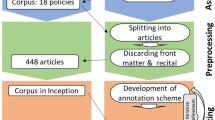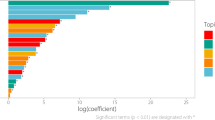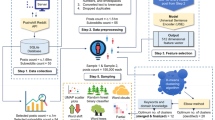Abstract
Machine learning presents opportunities for tracking evidence on climate change adaptation, including text-based methods from natural language processing. In theory, such tools can analyse more data in less time, using fewer resources and with less risk of bias. However, the first generation of adaptation studies have delivered only proof of concepts. Reviewing these first studies, we argue that future efforts should focus on creating more diverse datasets, investigating concrete hypotheses, fostering collaboration and promoting ‘machine learning literacy’, including understanding bias. More fundamentally, machine learning enables a paradigmatic shift towards automating repetitive tasks and makes interactive ‘living evidence’ platforms possible. Broadly, the adaptation community is failing to prepare for this shift. Flagship projects of organizations such as the IPCC could help to lead the way.
This is a preview of subscription content, access via your institution
Access options
Access Nature and 54 other Nature Portfolio journals
Get Nature+, our best-value online-access subscription
$29.99 / 30 days
cancel any time
Subscribe to this journal
Receive 12 print issues and online access
$209.00 per year
only $17.42 per issue
Buy this article
- Purchase on Springer Link
- Instant access to full article PDF
Prices may be subject to local taxes which are calculated during checkout
Similar content being viewed by others
Data availability
All of the data generated or analysed during this study are included in this published article and its supplementary information files.
References
IPCC Climate Change 2022: Impacts, Adaptation, and Vulnerability (eds Pörtner, H.-O. et al.) (Cambridge Univ. Press, 2022).
Berrang-Ford, L. et al. A systematic global stocktake of evidence on human adaptation to climate change. Nat. Clim. Change 11, 989–1000 (2021).
Sharm el-Sheikh Implementation Plan FCCC/PA/CMA/2022/L.21 (UNFCCC, 2022).
Berrang-Ford, L. et al. Tracking global climate change adaptation among governments. Nat. Clim. Change 9, 440–449 (2019).
Craft, B. & Fisher, S. Measuring the adaptation goal in the global stocktake of the Paris Agreement. Clim. Policy 18, 1203–1209 (2018).
Njuguna, L., Biesbroek, R., Crane, T. A., Tamás, P. & Dewulf, A. Designing fit-for-context climate change adaptation tracking: towards a framework for analyzing the institutional structures of knowledge production and use. Clim. Risk Manag. 35, 100401 (2022).
Olhoff, A., Väänänen, E. & Dickson, B. in Resilience (eds Zommers, Z. & Alverson, K.) 51–61 (Elsevier, 2018).
Dilling, L. et al. Is adaptation success a flawed concept? Nat. Clim. Change 9, 572–574 (2019).
Leiter, T. & Pringle, P. in Adaptation Metrics: Perspectives on Measuring, Aggregating and Comparing Adaptation Results (eds Christiansen, L. et al.) 29–48 (UNEP DTU, 2018).
Adaptation Gap Report 2022: Too Little, Too Slow—Climate Adaptation Failure Puts World at Risk (UNEP, 2022).
Callaghan, M. et al. Machine-learning-based evidence and attribution mapping of 100,000 climate impact studies. Nat. Clim. Change 11, 966–972 (2021).
Sietsma, A. J., Ford, J. D., Callaghan, M. W. & Minx, J. C. Progress in climate change adaptation research. Environ. Res. Lett. 16, 054038 (2021).
Berrang-Ford, L. et al. Systematic mapping of global research on climate and health: a machine learning review. Lancet Planet. Health 5, e514–e525 (2021).
Nunez-Mir, G. C., Iannone, B. V.III, Pijanowski, B. C., Kong, N. & Fei, S. Automated content analysis: addressing the big literature challenge in ecology and evolution. Methods Ecol. Evol. 7, 1262–1272 (2016).
Callaghan, M. W., Minx, J. C. & Forster, P. M. A topography of climate change research. Nat. Clim. Change 10, 118–123 (2020).
Nalau, J. & Verrall, B. Mapping the evolution and current trends in climate change adaptation science. Clim. Risk Manag. https://doi.org/10.1016/j.crm.2021.100290 (2021).
Schipper, E. L. F., Tanner, T., Dube, O. P., Adams, K. M. & Huq, S. The debate: is global development adapting to climate change? World Dev. Perspect. 18, 100205 (2020).
Siders, A. R. Adaptive capacity to climate change: a synthesis of concepts, methods, and findings in a fragmented field. Wiley Interdiscip. Rev. Clim. Change 10, e573 (2019).
Ford, J. D. et al. Big data has big potential for applications to climate change adaptation. Proc. Natl Acad. Sci. USA 113, 10729–10732 (2016).
Cheong, S. M., Sankaran, K. & Bastani, H. Artificial intelligence for climate change adaptation. Wiley Interdiscip. Rev. Data Min. Knowl. Discov. 13, e1459 (2022).
Lesnikowski, A. et al. Frontiers in data analytics for adaptation research: topic modeling. Wiley Interdiscip. Rev. Clim. Change 10, e576 (2019).
Biesbroek, R., Badloe, S. & Athanasiadis, I. N. Machine learning for research on climate change adaptation policy integration: an exploratory UK case study. Reg. Environ. Change 20, 85 (2020).
Biesbroek, R., Wright, S. J., Eguren, S. K., Bonotto, A. & Athanasiadis, I. N. Policy attention to climate change impacts, adaptation and vulnerability: a global assessment of National Communications (1994–2019). Clim. Policy 22, 97–111 (2022).
Zennaro, F. et al. Exploring machine learning potential for climate change risk assessment. Earth Sci. Rev. 220, 103752 (2021).
Karpatne, A., Ebert-Uphoff, I., Ravela, S., Babaie, H. A. & Kumar, V. Machine learning for the geosciences: challenges and opportunities. IEEE Trans. Knowl. Data Eng. 31, 1544–1554 (2018).
Munawar, H. S., Hammad, A. W. A. & Waller, S. T. A review on flood management technologies related to image processing and machine learning. Autom. Constr. 132, 103916 (2021).
Rolnick, D. et al. Tackling climate change with machine learning. ACM Comput. Surv. 55, 42 (2022).
Boussalis, C., Coan, T. G. & Holman, M. R. Communicating climate mitigation and adaptation efforts in American cities. Climate 7, 45 (2019).
Zander, K. K. et al. Topic modelling exposes disciplinary divergence in research on the nexus between human mobility and the environment. Humanit. Soc. Sci. Commun. 9, 34 (2022).
Fu, X., Li, C. & Zhai, W. Using natural language processing to read plans. J. Am. Plann. Assoc. https://doi.org/10.1080/01944363.2022.2038659 (2022).
Hsu, A. & Rauber, R. Diverse climate actors show limited coordination in a large-scale text analysis of strategy documents. Commun. Earth Environ. 2, 30 (2021).
Abarca-Alvarez, F. J., Navarro-Ligero, M. L., Valenzuela-Montes, L. M. & Campos-Sánchez, F. S. European strategies for adaptation to climate change with the Mayors Adapt initiative by self-organizing maps. Appl. Sci. 9, 3859 (2019).
Paulvannan Kanmani, A., Obringer, R., Rachunok, B. & Nateghi, R. Assessing global environmental sustainability via an unsupervised clustering framework. Sustainability 12, 563 (2020).
Valero, S. D., Emandi, R., Encarnacion, J., Kaul, S. & Seck, P. Utilizing big data to measure key connections between gender and climate change 1. Stat. J. IAOS 38, 973–994 (2022).
Lynam, T. Exploring social representations of adapting to climate change using topic modeling and Bayesian networks. Ecol. Soc. https://doi.org/10.5751/ES-08778-210416 (2016).
Blei, D. M., Ng, A. Y. & Jordan, M. I. Latent Dirichlet Allocation. J. Mach. Learn. Res. 3, 993–1022 (2003).
Tvinnereim, E., Fløttum, K., Gjerstad, Ø., Johannesson, M. P. & Nordø, Å. D. Citizens’ preferences for tackling climate change. Quantitative and qualitative analyses of their freely formulated solutions. Glob. Environ. Change 46, 34–41 (2017).
Sun, Y.-L., Zhang, C.-H., Lian, Y.-J. & Zhao, J.-M. Exploring the global research trends of cities and climate change based on a bibliometric analysis. Sustainability 14, 12302 (2022).
Rana, I. A., Lodhi, R. H., Zia, A., Jamshed, A. & Nawaz, A. Three-step neural network approach for predicting monsoon flood preparedness and adaptation: application in urban communities of Lahore, Pakistan. Urban Clim. 45, 101266 (2022).
Canon, M. J., Satuito, A. & Sy, C. Determining disaster risk management priorities through a neural network-based text classifier. In 2018 International Symposium on Computer, Consumer and Control (IS3C) 237–241 (2018).
Salam, R. et al. Nexus between vulnerability and adaptive capacity of drought-prone rural households in northern Bangladesh. Nat. Hazards 106, 509–527 (2021).
Abiodun, O. I. et al. State-of-the-art in artificial neural network applications: a survey. Heliyon 4, e00938 (2018).
Cervantes, J., Garcia-Lamont, F., Rodríguez-Mazahua, L. & Lopez, A. A comprehensive survey on support vector machine classification: applications, challenges and trends. Neurocomputing 408, 189–215 (2020).
Sietsma, A. J. et al. Machine learning evidence map reveals global differences in adaptation action. One Earth (in the press).
Bingler, J. A., Kraus, M., Leippold, M. & Webersinke, N. Cheap talk and cherry-picking: what ClimateBERT has to say on corporate climate risk disclosures. Financ. Res. Lett. 47, 102776 (2022).
Gillioz, A., Casas, J., Mugellini, E. & Khaled, O. A. Overview of the transformer-based models for NLP Tasks. In 2020 15th Conference on Computer Science and Information Systems (FedCSIS) 179–183 (2020).
Huo, F. et al. Using big data analytics to synthesize research domains and identify emerging fields in urban climatology. WIREs Clim. Change 12, e688 (2021).
Khalil, H., Ameen, D. & Zarnegar, A. Tools to support the automation of systematic reviews: a scoping review. J. Clin. Epidemiol. 144, 22–42 (2022).
Marshall, C., Sutton, A., O’Keefe, H. & Johnson, E. (eds) The Systematic Review Toolbox (2022); http://www.systematicreviewtools.com/
Gates, A. et al. Performance and usability of machine learning for screening in systematic reviews: a comparative evaluation of three tools. Syst. Rev. 8, 278 (2019).
Bisaro, A., Roggero, M. & Villamayor-Tomas, S. Institutional analysis in climate change adaptation research: a systematic literature review. Ecol. Econ. 151, 34–43 (2018).
Scheelbeek, P. F. et al. The effects on public health of climate change adaptation responses: a systematic review of evidence from low- and middle-income countries. Environ. Res. Lett. 16, 073001 (2021).
Naulleau, A., Gary, C., Prévot, L. & Hossard, L. Evaluating strategies for adaptation to climate change in grapevine production—a systematic review. Front. Plant Sci. 11, 607859 (2021).
Müller-Hansen, F., Callaghan, M. W. & Minx, J. C. Text as big data: develop codes of practice for rigorous computational text analysis in energy social science. Energy Res. Soc. Sci. 70, 101691 (2020).
Wu, P. Y., Tucker, J. A., Nagler, J. & Messing, S. Large language models can be used to estimate the ideologies of politicians. Preprint at https://arxiv.org/abs/2303.12057 (2023).
Hämäläinen, P., Tavast, M. & Kunnari, A. Evaluating large language models in generating synthetic HCI research data: a case study. In Proc. 2023 CHI Conference on Human Factors in Computing Systems 1–19 (2023).
Wei, J. et al. Emergent abilities of large language models. Preprint at https://arxiv.org/abs/2206.07682 (2022).
Canales, N., Klein, R. J. T., Bakhtaoui, I. & Macura, B. Assessing adaptation progress for the global stocktake. Nat. Clim. Change https://doi.org/10.1038/s41558-023-01656-x (2023).
Marsolek, W., Farrell, S. L., Kelly, J. A. & Cooper, K. Grey literature: advocating for diverse voices, increased use, improved access, and preservation. Coll. Res. Libr. News https://doi.org/10.5860/crln.82.2.58 (2021).
Poldrack, R. A., Lu, T. & Beguš, G. AI-assisted coding: experiments with GPT-4. Preprint at https://arxiv.org/abs/2304.13187 (2023).
Corringham, T. et al. BERT classification of Paris Agreement climate action plans. In ICML 2021 Workshop on Tackling Climate Change with Machine Learning 45 (2021).
Manandhar, A. et al. Machine learning to evaluate impacts of flood protection in Bangladesh, 1983–2014. Water 12, 483 (2020).
Sachdeva, S., Hsu, A., French, I. & Lim, E. A computational approach to analyzing climate strategies of cities pledging net zero. npj Urban Sustain. 2, 21 (2022).
Kim, B. J., Jeong, S. & Chung, J.-B. Research trends in vulnerability studies from 2000 to 2019: findings from a bibliometric analysis. Int. J. Disaster Risk Reduct. 56, 102141 (2021).
Jacobs, T. & Tschötschel, R. Topic models meet discourse analysis: a quantitative tool for a qualitative approach. Int. J. Soc. Res. Methodol. 22, 469–485 (2019).
Lyall, C. Being an Interdisciplinary Academic—How Institutions Shape University Careers (Springer Nature, 2019).
MacLeod, M. What makes interdisciplinarity difficult? Some consequences of domain specificity in interdisciplinary practice. Synthese 195, 697–720 (2018).
Miller, T. R. et al. Epistemological pluralism reorganizing interdisciplinary research. Ecol. Soc. 13, 46 (2008).
Haddaway, N. R., Macura, B., Whaley, P. & Pullin, A. S. ROSES Reporting Standards for Systematic Evidence Syntheses: pro forma, flow-diagram and descriptive summary of the plan and conduct of environmental systematic reviews and systematic maps. Environ. Evid. 7, 7 (2018).
Roberts, M. E. et al. Structural topic models for open‐ended survey responses. Am. J. Pol. Sci. 58, 1064–1082 (2014).
Miglionico, A. The use of technology in corporate management and reporting of climate-related risks. Eur. Bus. Organ. Law Rev. 23, 125–141 (2022).
Hovy, D. & Prabhumoye, S. Five sources of bias in natural language processing. Lang. Linguist. Compass 15, e12432 (2021).
Caliskan, A., Bryson, J. J. & Narayanan, A. Semantics derived automatically from language corpora contain human-like biases. Science 356, 183–186 (2017).
Guo, Y., Yang, Y. & Abbasi, A. Auto-debias: debiasing masked language models with automated biased prompts. In Proc. 60th Annual Meeting of the Association for Computational Linguistics 1012–1023 (ACL, 2022).
Xu, F. F., Alon, U., Neubig, G. & Hellendoorn, V. J. A systematic evaluation of large language models of code. In Proc. 6th ACM SIGPLAN International Symposium on Machine Programming 1–10 (ACM, 2022).
Garrido-Muñoz, I., Montejo-Ráez, A., Martínez-Santiago, F. & Ureña-López, L. A. A survey on bias in deep NLP. Appl. Sci. 11, 3184 (2021).
Magee, L., Ghahremanlou, L., Soldatic, K. & Robertson, S. Intersectional bias in causal language models. Preprint at https://arxiv.org/abs/2107.07691 (2021).
Lazer, D., Kennedy, R., King, G. & Vespignani, A. The parable of Google Flu: traps in big data analysis. Science 343, 1203–1205 (2014).
Bender, E. M., Gebru, T., McMillan-Major, A. & Shmitchell, S. On the dangers of stochastic parrots: can language models be too big? In Proc. 2021 ACM Conference on Fairness, Accountability, and Transparency 610–623 (ACM, 2021).
Haunschild, R., Leydesdorff, L., Bornmann, L., Hellsten, I. & Marx, W. Does the public discuss other topics on climate change than researchers? A comparison of explorative networks based on author keywords and hashtags. J. Informetr. 13, 695–707 (2019).
Wright, S. J., Sietsma, A. J., Korswagen, S., Athanasiadis, I. N. & Biesbroek, R. How do countries frame climate change? A global comparison of adaptation and mitigation in UNFCCC National Communications. Reg. Environ. Change 23, 129 (2023).
Smith, T. B., Vacca, R., Mantegazza, L. & Capua, I. Natural language processing and network analysis provide novel insights on policy and scientific discourse around Sustainable Development Goals. Sci. Rep. 11, 22427 (2021).
Berrang-Ford, L. et al. in Mapping Climate–Health Evidence: Using Machine-Learning to Map the Links Between Climate Change and Health 192 (Foreign, Commonwealth and Development Office, 2021).
Elliott, J. H. et al. Living systematic review: 1. Introduction—the why, what, when, and how. J. Clin. Epidemiol. 91, 23–30 (2017).
Millard, T. et al. Feasibility and acceptability of living systematic reviews: results from a mixed-methods evaluation. Syst. Rev. 8, 325 (2019).
Khalil, H., Tamara, L., Rada, G. & Akl, E. A. Challenges of evidence synthesis during the 2020 COVID pandemic: a scoping review. J. Clin. Epidemiol. 142, 10–18 (2022).
Climate Policy Radar Climate Policy Radar App https://app.climatepolicyradar.org/ (2023).
Liu, Y. et al. Summary of ChatGPT-related research and perspective towards the future of large language models. Meta-Radiology 1, 100017 (2023).
Floridi, L. & Chiriatti, M. GPT-3: its nature, scope, limits, and consequences. Minds Mach. 30, 681–694 (2020).
Debnath, R., Creutzig, F., Sovacool, B. K. & Shuckburgh, E. Harnessing human and machine intelligence for planetary-level climate action. npj Clim. Action 2, 20 (2023).
Huyer, S. & Gumucio, T. Going back to the well: women, agency, and climate adaptation. World J. Agric. Soil Sci. 5, WJASS.MS.ID.000611 (2020).
Wester, M. & Lama, P. D. in Climate Hazards, Disasters, and Gender Ramifications (eds Kinnvall C. & Rydstrom H.) 67–85 (Routledge, 2019).
Minx, J. C., Callaghan, M., Lamb, W. F., Garard, J. & Edenhofer, O. Learning about climate change solutions in the IPCC and beyond. Environ. Sci. Policy 77, 252–259 (2017).
Berrang-Ford, L. et al. Evidence synthesis for accelerated learning on climate solutions. Campbell Syst. Rev. https://doi.org/10.1002/cl2.1128 (2020).
Petticrew, M. & McCartney, G. Using systematic reviews to separate scientific from policy debate relevant to climate change. Am. J. Prev. Med. 40, 576–578 (2011).
Tol, R. S. J. Regulating knowledge monopolies: the case of the IPCC. Climatic Change 108, 827 (2011).
Provost, G. Rigorous and relevant: applying lessons from the history of IPCC special reports to the post-Paris Agreement world. Harvard Environ. Law Rev. 43, 507–546 (2019).
Kelman, I., Ayeb-Karlsson, S., Schipper, L., Pelling, M. & Beck, S. Learning from the History of Disaster Vulnerability and Resilience Research and Practice for Climate Change (UK Alliance for Disaster Research, 2022).
Tol, R. S. The IPCC and the challenge of ex post policy evaluation. Preprint at https://arxiv.org/abs/2207.14724 (2022).
Acknowledgements
A.J.S. acknowledges the support of this work by the UK Natural Environment Research Council (Panorama DTP). J.C.M. acknowledges funding by the European Research Council under the European Union’s Horizon 2020 Research and Innovation programme (GENIE Project, grant 951542).
Author information
Authors and Affiliations
Corresponding author
Ethics declarations
Competing interests
The authors declare no competing interests.
Peer review
Peer review information
Nature Climate Change thanks Vilhelm Verendel and the other, anonymous, reviewer(s) for their contribution to the peer review of this work.
Additional information
Publisher’s note Springer Nature remains neutral with regard to jurisdictional claims in published maps and institutional affiliations.
Supplementary information
Supplementary Information
Rapid review protocol.
Supplementary Data
All documents screened and included in the rapid review.
Rights and permissions
Springer Nature or its licensor (e.g. a society or other partner) holds exclusive rights to this article under a publishing agreement with the author(s) or other rightsholder(s); author self-archiving of the accepted manuscript version of this article is solely governed by the terms of such publishing agreement and applicable law.
About this article
Cite this article
Sietsma, A.J., Ford, J.D. & Minx, J.C. The next generation of machine learning for tracking adaptation texts. Nat. Clim. Chang. 14, 31–39 (2024). https://doi.org/10.1038/s41558-023-01890-3
Received:
Accepted:
Published:
Issue Date:
DOI: https://doi.org/10.1038/s41558-023-01890-3



